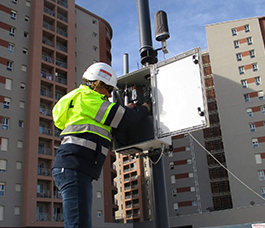Casella UK
Wolseley Rd, Kempston,Bedford MK42 7JY
+44(0)1234844100
info@casellasolutions.com

In 2016, Gibraltar International Airport achieved record passenger movements, with more than 500,000 passengers travelling through the airport by the end of November – a remarkable figure for the British Overseas Territory just 2.5 square miles in size.
Runway operation in Gibraltar currently requires the territory’s busiest highway to close, causing regular delays for passengers and drivers travelling to and from mainland Spain.
To combat this issue, ensuring the growth of the airport and improved access to this popular destination, an access road and tunnel project has been ongoing since 2008, involving the construction of a road 1.24 km long with two lanes in each direction ensuring the land border remains open at all times.
A 2016 report highlighted that Gibraltar is currently exceeding the World Health Organisation's recommended levels for air pollution, with pollutants that directly threaten the health of the population. The Gibraltar Best Practice Guide for Dust Control written by the Department of the Environment states that the local limit recommendations for Gibraltar in high risk areas such as the airport construction site should not exceed 250 μg/m3 over 15 minutes.
According to the Mayor of London’s report on ‘The Control of Dust and Emissions During Construction and Demolition (published July 2014)’, 15 percent of London’s airborne particulates are attributable to construction which together with the focus by the British Occupational Health Society (BOHS) on the adverse health implications for workers of silica present in construction dust, points to the control needs from both an environmental and health & safety perspective.
With an estimated 2,993 registered construction workers residing in Gibraltar and a large proportion of these individuals involved in this project, monitoring their environment to ensure exposures are kept to a minimum is crucial. The high levels of emissions already apparent in the atmosphere increases with the changing wind direction and there is a correlation between easterly and southern winds increasing high dust levels.
Good Measure
Lucia Diez Cadavid, Environmental Manager of the project is responsible for ensuring compliance with regulatory requirements, including the 2010 Environment Control of Dust Regulations, determining potentially negative impacts. Having successfully used it on an earlier project in Qatar, Diez Cadavid introduced Casella’s Boundary Guardian monitoring system to ensure project compliance with government regulations; the system is enabling her to primarily monitor dust and noise emissions. She is also using it to ascertain wind speed and direction. Diez Cadavid can remotely access this real time data as it automatically synchronises to a supporting website where the results can be instantly analysed.
Diez Cadavid says, “The Boundary Guardian provides me with live data that enables me to primarily check local regulatory limits are adhered to, but it also shown data that has enabled me to put improved preventative health and safety measures in place we provide screens, face masks and use sprinklers to keep emissions to a minimum.”
Making Changes
The Boundary Guardian is providing a key solution for monitoring regulatory limits and the data collected is allowing for further exploration. Recently, unidentifiable particles have been sent to a laboratory for testing to identify the origin and source, providing an educational insight for the future. Due to the instantaneous results, Diez Cadavid is required to submit weekly reports to the Environmental Agency providing evidence of compliance to dust and noise levels.
Commenting on the successful application of the device, Diez Cadavid says “ The immediacy that the Boundary Guardian provides is crucial and has enabled us to set up a constant dialogue with our workforce and Environmental Agency alike to demonstrate we are compliant and that worker health is a real priority for us in this project. “
Through use of the Boundary Guardian, Diez Cadavid is embracing the benefits of real-time data, harnessing the constant flows of information the system captures. As a result, productivity, morale and environmental compliance remain high on a project set to change how Gibraltar operates forever.
http://www.euroweeklynews.com/3.0.15/news/on-euro-weekly-news/gibraltar-news/142347-record-passenger-movements-through-gibraltar-international-airport
http://www.ohl.es/en/press-room/news/2016/june-2016/160620-ohl-agrees-with-the-goverment-of-gibraltar-to-complete-the-works-in-the-airport-access-tunnel/
http://chronicle.gi/2016/05/rock-has-poor-air-quality-who-report-finds/
Government of Gibraltar. Dust- Best Practise Guide. 2010.
https://www.london.gov.uk/file/18750/download?token=zV3ZKTpP www.breathefreely.org.uk/